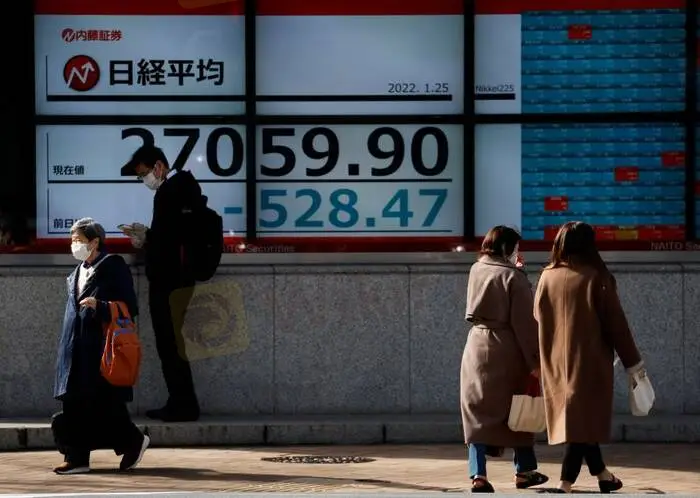简体中文
繁體中文
English
Pусский
日本語
ภาษาไทย
Tiếng Việt
Bahasa Indonesia
Español
हिन्दी
Filippiiniläinen
Français
Deutsch
Português
Türkçe
한국어
العربية
Equities tumble and U.S. dollar rises as Russia/ Ukraine fears escalate
Abstract:Asian stocks steadied on Wednesday and demand for safe-havens waned a little as investors regarded Russian troop movements near Ukraine and initial Western sanctions as leaving room to avoid a war, while a rate hike lifted New Zealands dollar.

Investors around the world lost their appetite for risk on Wednesday, with stocks selling off and the U.S. dollar gaining some ground as Ukraine declared a state of emergency amid intensifying fears of a full-scale Russian invasion.
Trading in many asset classes has been volatile since Russian President Vladimir Putins dispatch of troops earlier this week into parts of Ukraine. This triggered sanctions from Western countries and threats of more if Moscow advances further.
Oil futures, which were whipsawed during the day, settled well below their session highs and U.S. Treasury yields, while staying above Tuesdays close, were also volatile.
Ukraine declared a state of emergency and told its citizens to flee Russia, while Moscow began evacuating its Kyiv embassy. The Russian-backed separatist leader of a Ukrainian breakaway region said Ukrainian government forces should withdraw from territory that his self-proclaimed state has claimed and take their weapons with them.
A senior U.S. official said on Wednesday that Russia is as ready as it can be to launch what could be a full-scale invasion, with 80 percent of troops assembled around Ukraine in attack positions.
After rising as much as 0.7% earlier on Wednesday the MSCI World Index, a leading gauge of equity markets globally, reversed course in morning trading and deepened losses as the day wore on to finish off 1.2%, registering its lowest level since April 2021. After falling as much as 1% and rising almost 2% during the day, Brent crude settled unchanged from Tuesdays close at $96.84, while West Texas Intermediate settled up 0.21% at $92.10 per barrel after earlier falling as much as 1.9% and rising 1.7% all in the same day. [O/R]
Investors have also been grappling with the prospects of a U.S. Federal Reserve policy tightening aimed at combating surging inflation. But these worries have “been somewhat superseded by events in eastern Europe and in Russia,” said Rhys Williams, chief strategist at Spouting Rock Asset Management.
“So in the very short term, markets will go up or down based on whether (Putin) marches to Kyiv,” said Williams, adding that investors had appeared to accept Russias move into the Donetsk and Luhansk regions in Ukraine.
But if Putin “goes to Kyiv and there is a regime change and potentially a guerrilla war for the next two generations, thats a more difficult scenario and there is frankly only one person who can decide this.”
The Dow Jones Industrial Average fell 464.85 points, or 1.38%, to 33,131.76, barely above the 33,119.685 level that would have confirmed a correction.
The S&P 500 lost 79.26 points, or 1.84%, to end at 4,225.5 and the Nasdaq Composite dropped 344.03 points, or 2.57%, to 13,037.49.
Michael James, managing director of equity trading at Wedbush Securities in Los Angeles, said there was currently “very little positive validation for buying anything.”
“If anything, President Putin is digging his heels in despite the increased sanctions,” said James. “Thats really adding to elevated nervousness about further aggressive actions and what that will mean for commodities and inflation overall as well as potentially lower market prices as overall equity sentiment continues to worsen.”
Treasury yields were higher as investors monitored Russia-Ukraine events and remained concerned about inflation and a potential Federal Reserve policy mistake.
Benchmark 10-year notes last fell 13/32 in price to yield 1.9912%, up from 1.948% late on Tuesday. The 30-year bond last fell 30/32 in price to yield 2.2963% up from 2.253% while the 2-year note last fell 1/32 in price to yield 1.6016%, up from 1.587%.
Trading was also choppy in currencies with the dollar index last up 0.127% and the euro down 0.18% at $1.1305.
The U.S. dollar strengthened sharply and was last up 3.2% against the Russian rouble, more than reversing its losses on Tuesday against the Russian currency.
The New Zealand dollar NZD= jumped after the Reserve Bank of New Zealand raised interest rates and said more tightening could be necessary. The kiwi last was up 0.71% versus the greenback at $0.678.
Palladium rose 4.5% to a near six-month peak driven by fears of a hit to supply from top producer Russia. Gold added 0.6% to trade at $1,908.62 an ounce.
Russia is the world‘s third-largest producer of gold, while the country’s Nornickel is also a major producer of palladium and platinum, both of which are used in catalytic converters to clean car exhaust fumes.

Disclaimer:
The views in this article only represent the author's personal views, and do not constitute investment advice on this platform. This platform does not guarantee the accuracy, completeness and timeliness of the information in the article, and will not be liable for any loss caused by the use of or reliance on the information in the article.
Read more

Amillex Broker Login and Account Setup Guide 2025
You are here because you need clear instructions for the Amillex Broker login process or want to open a new Amillex Broker account. This guide is your complete resource. We provide a direct, step-by-step walkthrough for both new and existing traders. Our goal is to give you the exact information needed to access your account or get started with the platform safely and confidently. This complete manual covers everything from your first login to using your user dashboard and even setting up a practice account.

Top Tips to Avoid Forex Margin Calls and Protect Your Capital
While technical indicators or chart patterns often capture the attention of forex traders, especially new ones, aspects such as margin requirements, equity, used margin, free margin, and margin levels are often overlooked. So, if you have received a margin call from your forex broker and are wondering how to deal with it, you probably do not know the concept of a forex margin call - what triggers it and how to avoid it. Being unaware of this concept can make you lose your hard-earned capital. In this article, we will provide you with all the information you need to know. Keep reading!

Voices of the Golden Insight Award Jury | Peter Karsten, CEO STARTRADER
WikiFX Golden Insight Award uniting industry forces to build a safe and healthy forex ecosystem, driving industry innovation and sustainable development, launches a new feature series — “Voices of the Golden Insight Awards Jury.” Through in-depth conversations with distinguished judges, this series explores the evolving landscape of the forex industry and the shared mission to promote innovation, ethics, and sustainability.

A Guide to Determining the Optimum Forex Leverage
Want to gain a wider forex market position control by investing a minimal amount? Consider using leverage in forex. It implies using borrowed funds to raise your trading position more than your cash balance can let you do it. Forex traders usually employ leverage to churn out profits from relatively small currency pair price changes. However, there is a double-edged sword with leverage since it can multiply profits as well as losses. Therefore, using leverage in the right amount is key for traders. Forex market leverage can be 50:1 to 100:1 or more, which remains significantly greater than the 2: leverage usually offered in equities and 15:1 leverage in futures.
WikiFX Broker
WikiFX Broker
Latest News
MH Markets Review 2025: Trading Platforms, Pros and Cons
Octa FX in Pakistan: The Complete Guide to Local Payments, Regulation, and Support
Mekness Review: Traders Report Alleged Fund Scams & Account Blocks
INTERPOL, AFRIPOL Crack Down on Africa Terror Finance
Forex Scam Checker Philippines: Verify Brokers with WikiFX
D Prime to Exit Limassol Office Amid Doo Group Restructure
Fake Trading Platforms Are Spreading Fast Across Asia | How Investors Are Being Tricked
WikiFX Elites Club Committee Concludes Voting! Inaugural Lineup Officially Announced
eToro CopyTrader Expands to U.S. Investors
Is MH Markets Safe or a Scam? Regulation and Fund Security Explained
Currency Calculator



